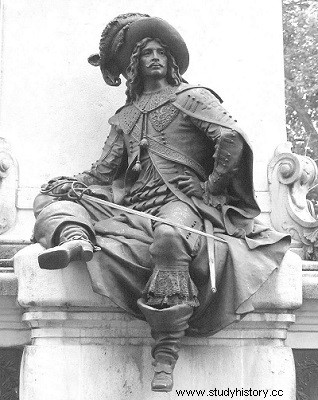
From his real name Charles de Batz-Castelmore, d'Artagnan was a French warrior born between 1611 and 1615 at the Château de Castelmore, near Lupiac, in Gascony (in the current department of Gers) and died at the siege of Maastricht on June 25, 1673.
His protectors
When the young Charles de Batz left Castelmore for Paris around 1640, he took the name of his mother, Françoise de Montesquiou d'Artagnan:indeed, the Montesquiou family was better introduced to the Court than his father's family, and Artagnan was a lordship of Bigorre belonging to this family. He joined the Cadets of the French Guards, the Military School of the time. M. de Tréville, captain of the Company of the King's Musketeers, assigned him to the Company of Essarts of the French Guards in Fontainebleau. His entry into the Musketeers, with the protection of Mazarin, dates from 1644, at the same time as that of his friend François de Montlezun, lord of Besmaux near Auch and future governor of the Bastille.
The company of the Musketeers was dissolved by Mazarin in 1646. The cardinal charged d'Artagnan, during the Fronde, with a certain number of missions to the military leaders. Louis XIV, who knew him in those years when he himself was a child, will then place his perfect trust in him and entrust him with numerous missions requiring diligence and discretion. During Mazarin's exile to Brühl in 1651, d'Artagnan accompanied the minister. This loyalty is repaid:in 1652, d'Artagnan is a lieutenant in the Gardes-Françaises; in 1655 he was captain, a charge he bought for 80,000 pounds. This sum was lent to him by other devotees of Mazarin, notably Colbert, then at the start of his career.
D'Artagnan Musketeer
In 1657, the first company of musketeers (known as the "great musketeers" or "grey musketeers", because of the dress of their horses) was reformed and d'Artagnan became a second lieutenant. He assumed the real command, the nominal leader being a nephew of Mazarin.
In 1659, d'Artagnan married Charlotte-Anne de Chancelay, who gave him two sons in 1660 and 1661. They separated from property and body in 1665.
In 1660, Louis XIV married the Infanta of Spain. The ceremony takes place on June 9 in Saint-Jean-de-Luz. The trip to the Basque Country lasted a year, and gave Louis XIV the opportunity to visit the southern provinces of his kingdom. Of course, d'Artagnan accompanies the procession. The crossing of the stopover towns arouses the admiration of the populations:the proud musketeers precede the royal carriage pulled by six white horses. On the day of the stopover in Vic-Fezensac, April 26, 1660, d'Artagnan rode to Castelmore to see his family again and to meditate at the tomb of his parents, in the estate's chapel.
In 1667, he became captain-lieutenant of the first company of Musketeers.
The arrest of Fouquet
On September 5, 1661, the king entrusted d'Artagnan with the delicate task of arresting Nicolas Fouquet, during the Council meeting in Nantes. Then begins a long period where the musketeer, transformed into a jailer, accompanies his prisoner in his successive places of incarceration:three months in the castle of Angers, then in the donjon of Vincennes, on June 20 of the following year in the Bastille and finally in Pignerol. During these long months, a vigilant jailer, he took personal care of his prisoner, filtering his visitors and scrupulously reporting to high places all the details of the life of the prisoner with whom, despite the rigors of detention, he maintained relations. almost friendly. Madame de Sévigné will report with what diligence d'Artagnan made the transfer and detention of Fouquet as painless as possible. Ten years later, he will proceed in a similar way to the arrest of Lauzun.
His end
D'Artagnan becomes governor of Lille, won by France in 1667. He was an unpopular governor and thought only of returning to the battlefield. He had the opportunity when Louis XIV began the Dutch War in 1672 against the United Provinces. He died there in 1673, during the siege of Maastricht, killed by a musket ball hit in the throat while he was fighting on a day off... The legend can begin.
D'Artagnan, a character from a novel
D'Artagnan is a character who really existed but of whom we ultimately know very little. There is only one portrait of him, the authenticity of which is not guaranteed, and memoirs where the true mixes with the false, published in 1700, 27 years after his death. They are the fruit of Gatien de Courtilz de Sandras, who discovered the life of the Gascon hero during one of his stays at the Bastille, when Besmaux, ex-companion of d'Artagnan, was Governor.
Alexandre Dumas in turn discovers the life of d'Artagnan through these memoirs. He is enthusiastic about the character and makes the book his bedside book. He is inspired by it for the writing of his famous trilogy:
1. The Three Musketeers;
2. Twenty Years Later;
3. The Viscount of Bragelonne.
Historical reality, again, is not his major concern, since he advances the action by 15 years (d'Artagnan thus participates in the siege of La Rochelle), he opposes Louis XIII to Richelieu and invents the character of Milady de Winter and the affair of Anne of Austria with the Duke of Buckingham.
Subsequently, d'Artagnan became one of the most recurring characters in cinema.
His character also appears in Cyrano de Bergerac by Edmond Rostand.
